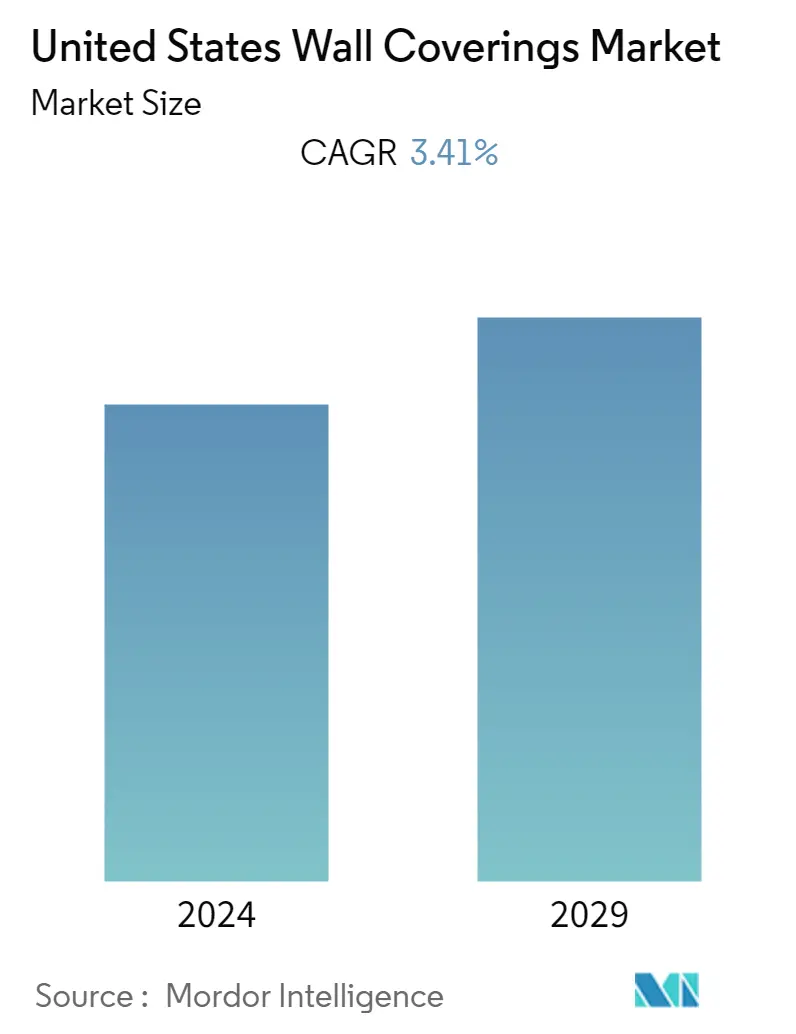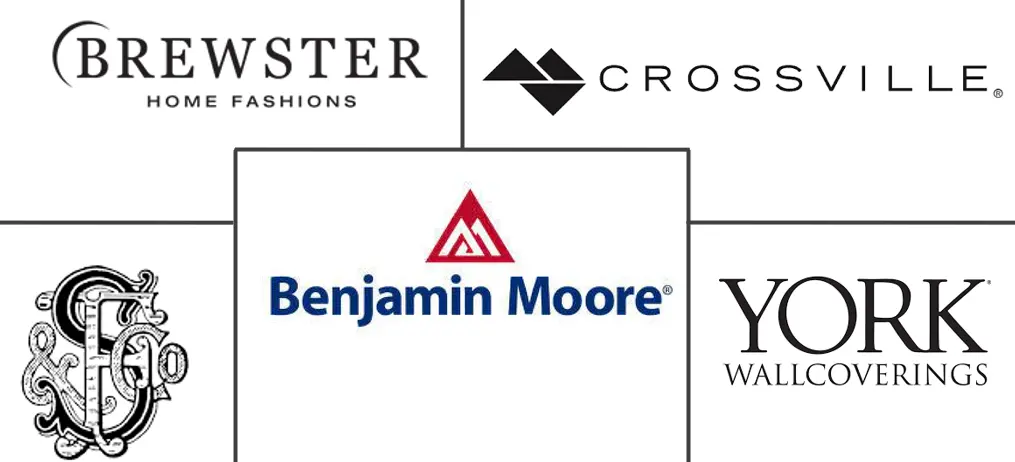
| Study Period | 2019 - 2029 |
| Base Year For Estimation | 2023 |
| Forecast Data Period | 2024 - 2029 |
| Historical Data Period | 2019 - 2022 |
| CAGR | 3.41 % |
| Market Concentration | Medium |
Major Players
*Disclaimer: Major Players sorted in no particular order |
US Wall Coverings Market Analysis
The United States Wall Covering Market registered at a CAGR of 3.41% during the forecast period (2022-2027). Gains in the US Wallcovering Market be driven by a recovery in construction activity, especially in the residential sector of the region. Demand for wall coverings has also benefitted from the turnaround in the prospects for wallpaper, which has suffered from negative consumer perceptions and stiff competition from paint and coatings. The region's increasing disposable income and rapid urbanization have resulted in the increasing usage of wall coverings, along with other modern products, such as window frames with very low heat transmission, electrical cables and conduits, easily cleaned flooring, and light-reflecting roofing. Marketing environmental factors such as interest rates, new housing, commercial construction statistics, homeowner remodeling, and repair spending have also been driving the market.
- The expansion of the wall coverings market is driven by rising standards of living, the desire for a luxurious existence, and household customization due to increased disposable income. Furthermore, advancements in innovation and better-quality items, such as bespoke 3D walls printed with ink-jet printing technology, have enticed high-income consumers to purchase wall coverings.
- Most wall covering products are simple to maintain and long-lasting, projected to increase customer demand. As a result of the expanding population and urbanization, investments in infrastructure activities are likely to promote the growth of the wall coverings market throughout the forecast period.
- Paint is considered a better alternative, as compared to wall coverings in specific uses. Furthermore, removing existing wallpaper can be a tiresome task that needs the right tools to be efficient. Stripping wallpaper can be achieved with chemicals or stripping tools, but care must be taken, or the wall can be damage.
- According to Dodge Construction Network, the value of commercial and multifamily construction starts in the top 20 metropolitan regions of the United States climbed 18% from 2020 to 2021. Nationally, commercial and multifamily construction in the United States rose by 16% in 2021. Commercial and multifamily starts increased 18% in the top half (the top ten metro areas) in 2021, with two metro areas, Washington, DC, and Los Angeles, CA, reporting declines.
- The New constructions in this region increase an opportunity for the Wall coverings market suppliers. For instance, According to BEA, The construction sector in the United States is one of the world's largest, with private spending continuing to rise year after year and around 8 million people employed. By 2023, new construction is estimated to be worth USD 1,449 billion.
- During the Pandemic, new home development was further hampered by the closure of government agencies that provided permits and disruptions in the supply chain for construction supplies. which also affected the Wall Coverings Market in the United States.
- Despite the Pandemic, there is some good news for renters in 2021: According to a recent survey from RentCafé, rental property construction has stayed at almost the same rate as in the preceding four active years of apartment construction. For the fifth year in a row, over 330,000 new rental units are scheduled to open across the United States in 2021.
US Wall Coverings Industry Segmentation
Wall covering protects the wall surface from accidental marks or scratches, besides imparting an air of quality and grandeur to uncovered walls. They further help in neutralizing the interior and customizing it with the help of various colors and patterns. Also, these coverings are cost-effective. The two common areas of applications of wall coverings include residential and commercial. Residential wall coverings are mainly used in homes and in small businesses to add attractiveness to rooms and to express an individual style. The market is segmented by product type, application, and distribution types across United States.
| Wall Panel | |
| Tiles | |
| Metal Wall | |
| Wallpaper | Vinyl |
| Non-woven Wallpaper | |
| Paper-based Wallpaper | |
| Fabric Wallpapers | |
| Other Wallpaper Types |
| Residential |
| Commercial |
| Specialty Store |
| Home Center |
| Furniture Store |
| Mass Merchandizer |
| E-commerce |
| Other End Users |
United States Wall Coverings Market Size Summary
The United States wall coverings market is experiencing a steady growth trajectory, driven by a resurgence in construction activities, particularly within the residential sector. This growth is further bolstered by the evolving consumer perceptions of wallpaper, which is regaining popularity despite previous competition from paint and coatings. The market is benefiting from increased disposable income and rapid urbanization, leading to a higher demand for modern home products, including wall coverings. Factors such as interest rates, new housing developments, and commercial construction activities are also contributing to the market's expansion. The desire for luxurious living and personalized home spaces, supported by advancements in technology and high-quality products, is attracting consumers, especially those with higher incomes, to invest in wall coverings.
The market is characterized by moderate competition, with several major players holding significant market shares. These companies are actively expanding their customer bases and enhancing their product offerings through strategic collaborations and acquisitions. Innovations in wallpaper technology, such as the use of non-woven backing and breathable fabrics, are improving the appeal and functionality of wall coverings, thereby boosting demand in both commercial and residential sectors. The market's growth is also supported by ongoing investments in environmentally friendly products and the development of new construction projects, which present opportunities for wall covering suppliers. Despite challenges such as the labor-intensive process of removing wallpaper, the market continues to thrive, driven by the increasing popularity of wall coverings as a preferred choice for home and office aesthetics.
United States Wall Coverings Market Size - Table of Contents
1. MARKET DYNAMICS
- 1.1 Market Overview
- 1.2 Introduction to Market Drivers and Restraints
-
1.3 Market Drivers
- 1.3.1 Rebounding Residential Construction Activity
- 1.3.2 Recovery in Wall Panel Sales Aided by Higher Awareness
- 1.3.3 Increasing Demand for Digitally Printed Solutions
- 1.3.4 Growth in Non-woven and Paper-based Wallpapers
-
1.4 Market Restraints
- 1.4.1 Strong Competition from the Paints Segment
- 1.4.2 Recent Changes in Macro-environment Expected to Impact Customer Spending
- 1.5 Industry Value Chain Analysis
-
1.6 Industry Attractiveness - Porter's Five Force Analysis
- 1.6.1 Threat of New Entrants
- 1.6.2 Bargaining Power of Buyers/Consumers
- 1.6.3 Bargaining Power of Suppliers
- 1.6.4 Threat of Substitute Products
- 1.6.5 Intensity of Competitive Rivalry
- 1.7 Import-Export Analysis for Wallcoverings and Wallpapers
- 1.8 Customer Spending Trends on Wallcoverings and Other Key Alternatives in the United States
- 1.9 Impact of COVID-19 on the Wallcoverings Industry
-
1.10 Key Product Innovations
- 1.10.1 Eco-Friendly Wallcoverings
- 1.10.2 Plank Prints
- 1.10.3 Digital Printing advancements
- 1.10.4 Light Absorbing Wallcoverings
2. MARKET SEGMENTATION
-
2.1 By Type
- 2.1.1 Wall Panel
- 2.1.2 Tiles
- 2.1.3 Metal Wall
- 2.1.4 Wallpaper
- 2.1.4.1 Vinyl
- 2.1.4.2 Non-woven Wallpaper
- 2.1.4.3 Paper-based Wallpaper
- 2.1.4.4 Fabric Wallpapers
- 2.1.4.5 Other Wallpaper Types
-
2.2 By Application
- 2.2.1 Residential
- 2.2.2 Commercial
-
2.3 By End User
- 2.3.1 Specialty Store
- 2.3.2 Home Center
- 2.3.3 Furniture Store
- 2.3.4 Mass Merchandizer
- 2.3.5 E-commerce
- 2.3.6 Other End Users
US Wall Coverings Market Research FAQs
What is the current United States Wall Coverings Market size?
The United States Wall Coverings Market is projected to register a CAGR of 3.41% during the forecast period (2024-2029)
Who are the key players in United States Wall Coverings Market?
Brewster Home Fashion, Benjamin Moore & Co., York Wall Coverings, F. Schumacher and Crossville Inc. are the major companies operating in the United States Wall Coverings Market.


